
Anand has been a print and broadcast journalist in Canada. His translations of Hindi fiction into English have been published by Penguin India and Rupa Books. He has also translated Canadian fiction writers, including the 2013 Nobel Prize winner Alice Munro into Hindi. He divides his time between Montreal, Canada and Lucknow, India.
The King of Rock n Roll was a swarthy teenager who couldn’t have been over 5 feet 6 inches tall.
His claim to fame was a crest on his blue blazer that showed a guitar and curlicues that said, "King of Rock n Roll."
If you went to an English-medium (or convent) school in India in 1950s and 1960s, you'd know what kind of blazer I am talking about. These blazers with crests of schools have now become very common in India. Every school with the name of a saint (sometimes, imaginary saint) attached to it has a school dress with a blazer and a tie. The blazer is worn only in the winter, but the tie, sometimes looking like a twisted rope, is de rigueur.
No one had heard the King sing, or seen him play the guitar. No one knew if he could even play the instrument. In 1960, rock n roll had caught the fancy of teenagers in India as mainly dance music\; it was its nascent stage and the genre that we know today as rock music was yet to come.